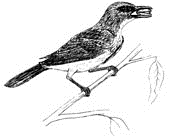Vertebrate Pest Conference: Proceedings

Vertebrate Pest Conference Proceedings: 17th (1996)
Date of this Version
1996
Document Type
Article
Citation
Published in Proceedings: Seventeenth Vertebrate Pest Conference … 1996, ed. Robert M. Timm & A. Charles Crabb (University of California, Davis, 1996).
Abstract
Black rats (Rattus rattus) cause extensive damage in Hawaiian macadamia (Macadamia integrifolia) orchards. In a previous study, extensive and persistent snap trapping significantly reduced rat populations and depredations on developing macadamia nuts, but had little effect on subsequent yields of mature nuts. This suggested that macadamia trees may compensate for rat damage, and that commonly used indices based on rodent activity and proportion of nuts damaged may overestimate the impact of rodent depredations and exaggerate the effectiveness of control measures. To clarify the effects of rat feeding on developing macadamia nuts, two levels of damage at two times during nut development and evaluated yields of mature nuts were simulated. Both number of nuts per raceme (P = 0.0001) and total weight of mature kernels per raceme (P = 0.0001), but not mean weight per mature kernel (P = 0.90), varied among treatments. Both number of nuts and total weight of kernels decreased (P < 0.05) with increasing damage. Time during nut development that damage was simulated had no apparent effect (P >0.05) on yields. These results indicate that racemes did not compensate for damage by retaining other nuts on the same raceme that might otherwise have dropped prematurely. A variance component analysis was also conducted to determine how best to sample the orchard in a practical fashion while minimizing potential sources of bias and retaining sensitivity for distinguishing among treatment effects. All of the random variability in the number of nuts per raceme and total weight of nuts per raceme, and > 93 % of the variability in mean weight per mature nut were due to variability between racemes on a tree. Thus, blocking was not needed to control for variability among the different areas in the orchard; sampling fewer trees and concentrating available resources on measuring more racemes per tree would have provided a more sensitive comparison of treatments. Focusing on entire branches or trees instead of racemes as experimental units might have provided a more realistic model for investigating compensatory mechanisms in macadamia trees.
Included in
Animal Sciences Commons, Bioresource and Agricultural Engineering Commons, Environmental Engineering Commons


Comments
Copyright © 1996 (where applicable) by the Vertebrate Pest Council of the Vertebrate Pest Conference. Used by permission.